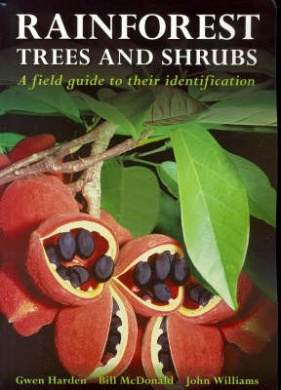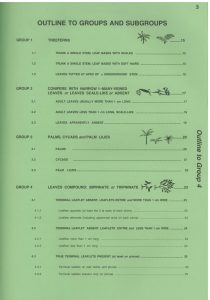 Rainforest Trees and Shrubs
Rainforest Trees and Shrubs
Plant identification
Gwen Harden Publishing
2006
264
0977555305
drawings
mixed botanical name and common name index

An identification guide to rainforest trees and shrubs from Victoria, New South Wales and subtropical Queensland using vegetative features.
Buy from: Gwen Harden Publishing
Easy identification of rainforest trees and shrubs for keen naturalists
‘Rainforest Trees and Shrubs’ is an essential book to identify rainforest trees and shrubs in Victoria, New South Wales and subtropical Queensland (subtropical eastern mainland Australia).
Like the other book by the same authors on rainforest climbing plants, this book is unique in allowing the reader to identify rainforest trees and shrubs using vegetative characteristics. Unlike floral and fruit characters, which are only available at certain times of the year, vegetative characters are available year-round.
Content overview
The first part of the book shortly describes the different rainforest types and provides a guide to the special features in rainforest plants that are useful in plant identification. There are two maps that show where rainforest patches occur in Queensland and in New South Wales and Victoria.

The second part of the book includes an identification key that splits the rainforest trees and shrubs described in the book into 17 groups. For each of these groups, there is another identification key that allows identification to subgroup level.
In the third part, the groups and subgroups defined in the second part and their species are described in more detail. The plants in these groups are organised by subgroup using combinations of characteristics.
Within each subgroup, species that have the defined combination of characteristics, are listed using the scientific name (but a common name is also provided) and described. Details of each plant’s vegetative and fruit characteristics are provided. In addition, one or more drawings of some of the characteristic features accompany the descriptions. The descriptions and illustrations are detailed and very useful.
Book audience
This is a book for naturalists who have some experience in using plant identification keys and who are very keen to identify rainforest plants in Australia. The plant identification keys require some knowledge of botanical terminology. However, because the book has a detailed glossary, a keen beginner will also be able to use these keys.
This book is the perfect addition to the other book by the same authors on rainforest climbing plants.
Key features of the book
The key features of this book are:
- plant identification keys that use vegetative (non-flowering) characteristics
- detailed drawings
- excellent species descriptions.
The most important feature of this book is the use of vegetative (non-flowering) characteristics to identify rainforest trees and shrubs. This is invaluable as it allows you to identify plants outside their flowering period. The numerous drawings of plant parts are equally valuable as they make it easy to scan and compare characteristics quickly.

To identify specimens, you will need a strong hand lens of 10 times magnification. You will also need some good leaf material of the plant you are trying to identify. In addition, you also need to be reasonably sure the plant grows in or near a rainforest patch in eastern mainland Australia.
This book also gives good botanical explanations of the important leaf characteristics. This, together with the glossary, will allow both experienced and less experience naturalists to use this book.
While I especially appreciate the focus on vegetative characteristics in the identification keys, it would have been very useful if the descriptions also included flowering characteristics. When in doubt about an identification, flowering characteristics can make the final steps in the identification process easier if flowers are available.
Additional features
This book has a number of other valuable features:
- a special section focusing on typical characteristics of rainforest plants
- an illustrated glossary
- a mixed botanical and common plant name index.
The illustrated glossary is very valuable and is easy to find as it is printed on green paper. The index is an absolute ‘must’ for a book such as this and is excellent.
Conclusion
‘Rainforest Trees and Shrubs’ is a great plant identification book that is unique in its ability to use vegetative characters. If you are already familiar with the process of plant identification, you will find this book invaluable. The book is certain to help you identify many of the rainforest trees and shrubs you will come across in the rainforest patches of Queensland, New South Wales or Victoria.
Related resources
Plant identification: Native Trees and Shrubs of South-eastern Australia (NSW, SA, VIC), Rainforest Climbing Plants (NSW, QLD, VIC)
Animal identification: Birds of Australia app (Australia-wide)
Free online: PlantNET (New South Wales Flora Online), Atlas of Living Australia (Australia-wide)
Do you have this book?
If you have a copy of ‘Rainforest Trees and Shrubs’, I would love to hear from you!
Let me know how you are using the book and explain your special concern/praise for the book. Can you recommend other books like this?
Of course, you are also most welcome to give general comments about the website!
Note: When submitting your reply below, please keep in mind that this website is monitored for spam. This means it may take a few days for your comment to appear on the page.


I have the original soft cover ‘red book’ with its longer title, purchased some time in the 1990’s, an invaluable aid to the identification of rainforest species in my backyard in the Lamington/ Border ranges area south of Beaudesert, Qld. I daresay it’s a collector’s edition now, since I’ve never come across it again. It has been my biological bible for over 35 years and has never failed me. I was in my early 20’s at the time I planted 15 000 trees on 7 acres of steep, eroding, slipping hillside, all grown from seed i collected in the area. These trees are now towering giants almost completely reversing the damage of 200 years of clearing and cattle grazing. I havent lived there for 20 years, having moved to a very different environment and a substantially larger block of land with completely different vegetation in the Granite Belt, but I still use the book to identify the few marginal species that grow in sheltered places. I particularly like the vegetative keys. I live at Tumbledown Nature Refuge, a lovely remnant of granite and intact heathy woodland. The new owner of ‘Treebeard’, is the proud heiress of those wonderful trees I planted as seedlings and she also has a passion for native forests, and continues her good work keeping weeds at bay and continuing to improve the forest’s chance of survival. I dont think I could have done it without the red book.
jayn
Thanks very much for your comment, Jayn. I agree absolutely.
What a great story of revival. It sounds amazing to have reinstated rainforest on your block!
Identifying rainforest species can be a big challenge, as it can be really hard to find flowering or fruiting identification material. So to be able to identify plants based on leaves and other vegetative characters is very useful. I also use this book frequently for identification at the NSW South Coast. An absolute treasure.